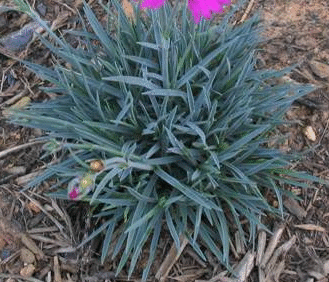Dianthus Maiden Pinks
Dianthus Maiden Pinks close their blooms at dusk
The Dianthus genus includes hardy perennials most notably the “pinks” (Dianthus superbus), as well as biennials and short lived perennials such as the Sweet Williams (Dianthus barbatus), and annuals. Carnations (Dianthus caryophyllus) are also a part of the Dianthus genus, some are hardy and some are not. In northern gardens, some Dianthus can only be grown as annuals. Select your Dianthus carefully to be sure you are getting a hardy perennial.
Superbus is the subspecies that includes the “pinks”. Dianthus superbus are referred to as the Garden Pinks or Wild Pinks. Pinks are easy to grow and very hardy. Dianthus plumarius are ‘Feathered Pinks’ and heirloom pinks referred to as Large Pinks, very hardy and difficult to find. Dianthus gratianopolitanus are the Cheddar Pinks. Dianthus deltoides are Maiden Pinks. Dianthus monspessulanus are Fringed Pinks. Dianthus chinensis are the China Pinks. And then of course, there are the hybrids. Once planted in well drained soil with plenty of sun, occasional water and division every few years is about all they need. Cottage garden pinks are excellent low growing, prolific bloomers for the front of a border, rock garden or edging.
Maiden Pinks partially close their blooms (like shy maidens) at dusk, which is where their common name came from. The blooms are often pink to red-pink but can also be white or spotted with white. Dianthus deltoides, or Maiden Pinks, have a dark ring near the bloom center. Shearing back spent blooms will encourage reblooming and minimize self seeding. Maiden Pinks can seed rather aggressively if allowed. Forming a loose mat, they spread slowly by underground rhizomes, excellent for a colorful groundcover. Maiden Pinks are easy to grow from seed, seeds started indoors early will bloom their first year. Dianthus are a short lived perennial, so divide every three years to maintain plant health and produce new plants, or allow to self seed to produce fresh plants. Avoid mulching heavily with organic mulches, which may encourage fungus to afflict the delicate stems. Maiden Pinks are easy to grow and care for, excellent for beginning gardeners. In warm regions, the foliage is evergreen and remains attractive year round.
Dianthus deltoides ‘Brilliant’
Common Name: Maiden Pinks
Plant Type: Herbaceous evergreen perennial
Height: 6-8”
Spread: 12-18”
Sun/Shade Requirements: Full sun to light shade
Water Requirements: Very adaptable but prefers average watering, do not over water.
Soil Requirements: Soil must be well drained, prefers neutral to alkaline pH. Will tolerate most soil conditions.
Growth Habit: Loosely tufted clumps
Bloom Time: May through July, repeating through September
Bloom Color: Bright scarlet with a darker red center halo
Bloom Form: 1/2 - 3/4” single blooms with five broad petals notched at the outer edges.
Foliage: Very narrow green leaves with pointed tips.
Fragrance: Light sweet fragrance
Pest and Disease Resistance: Susceptible to crown rot if over watered or if soil is poorly drained. Deer resistant.
Fertilize: Apply water soluble fertilizer every 4-6 weeks.
Maintenance: Divide in spring or fall.
Other: Attracts butterflies and hummingbirds.
Hardiness: Zones 2-9
‘Brilliant’ is a perfect choice for poor soils and hot conditions. The delicate looking plant and dainty flowers are amazingly tough and very tolerant of urban conditions. Light shade is tolerated, particularly in the afternoon in hot regions. The plant is completely covered with vibrant crimson blooms during late spring and early summer. Continued blooming is encouraged by deadheading when blooms are spent. ‘Brilliant’ is very short, ideal for edging a perennial border or walkway, and will even hold up to a little foot traffic. ‘Brilliant’ is also salt tolerant and will do fairly well in roadside gardens. The dark green foliage remains fresh looking year round, turning slightly purple-red in winter.
Dianthus deltoides ‘Arctic Fire’
Common Name: Maiden Pinks
Plant Type: Herbaceous evergreenperennial
Height: 6-8”
Spread: 12-15”
Sun/Shade Requirements: Full sun to light shade
Water Requirements: Very adaptable but prefers average watering, do not over water.
Soil Requirements: Soil must be well drained, prefers neutral to alkaline pH. Will tolerate most soil conditions.
Growth Habit: Loosely tufted clumps
Bloom Time: May through July, repeating through September
Bloom Color: White with bright fuchsia pink halo around pink center
Bloom Form: 1” single blooms with five broad petals notched at the outer edges.
Foliage: Very narrow green leaves with pointed tips.
Fragrance: Light sweet fragrance
Pest and Disease Resistance: Susceptible to crown rot if over watered or if soil is poorly drained.
Fertilize: Lightly fragrant.
Maintenance: Divide in spring or fall.
Other: Attracts butterflies and hummingbirds.
Hardiness: Zones 3-9
‘Arctic Fire’ is striking when planted in masses, groups, or as a border edging. The glowing cheery blooms smother the plant from spring into summer. Deadheading will encourage blooming into autumn. It will lightly self seed if not deadheaded. When grown from seed, blooming is abundant just 3 or 4 months after planting. ‘Arctic Fire’ is a wonderful filler around rose bushes or in spring bulb gardens. ‘Arctic Fire’ is fairly shade tolerant and will do quite well in a half day shade. In regions with hot summers, afternoon shade will benefit the plant. The dark limey green foliage is evergreen in all but the coldest regions.


